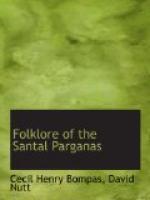“That is a lesson to the hyaena not to scold us and get us into trouble,” said the jackal, as he went home.
CXX. The Crow and the Egret.
A crow and a white egret once made their nests in the same tree, and when the nestlings began to grow up the crow saw how pretty and white the young egrets were, and thought them much nicer than her own black young ones. So one day when the egret was away, the crow changed the nestlings and brought the little white egrets, to her own nest. When the mother egret returned and found the ugly little black crows in her own nest, it did not take her long to see what had happened and she at once taxed the crow with the theft. The crow denied all knowledge of the matter and a fine quarrel ensued.
Quarrelling led to nothing and they agreed to refer the dispute to the decision of a money-lender, whose house stood by the tree in which the two nests were. The crow, as the less shy of the two, flew down and asked the money-lender to come out and settle their dispute. The first question the money-lender asked was what they were going to give him. The egret promised to catch him a fine rohu fish, which was what she was accustomed to eat, but the crow said that she would give him a golden necklace. The money-lender said that the fees must be brought first before he heard the case, so the egret flew off and caught a big fish, but the crow went to where a Raja was bathing and carried off the gold chain which the Raja had left on the bank of the river. The money-lender then gave his decision, which was in favour of the party who had given him the most valuable present; he decided that the young birds must stay where they were. “But,” protested the egret “how have my white nestlings become black?” “That is quite natural” answered the money-lender, “a white cow may have a black or brown calf: why should not you have black young ones?” And so saying he drove them away.
The poor egret was not at all content with this unjust decision, and was about to renew the quarrel, when a jackal came racing by; it had just made its escape from some hunters. “Where are you off to so fast, uncle?” called out the egret. “I am in arrears with my rent and am hurrying to pay it to the Raja,” answered the jackal. “Stay and listen to my grievance,” begged the egret, and she told the jackal all that had happened and how the money-lender had let himself be bribed by the gold necklace. The jackal was very indignant, “A man who could give a decision like that would call a buffalo, a bullock or a pig, a sheep. It is no decision at all; I cannot stop now, but I will come back to-morrow and decide the matter for you and before doing so, I will stuff the mouth of that unjust judge with filth.” So saying the jackal hurried off.
The money-lender heard all that passed and was filled with shame at having earned the contempt of the jackal; he feared more disgrace on the morrow, so he at once called the crow and made her return the egret’s nestlings, and the next morning when the jackal came back it found that everything had been settled to the satisfaction of the egret.




